上肢运动准备过程中的皮质脊髓兴奋性反映了屈肌的协同作用:基于主成分的新型运动诱发电位分析
IF 1.6
4区 医学
Q4 NEUROSCIENCES
引用次数: 0
摘要
背景:以往的研究表明,无创脑部刺激可用于研究中枢神经系统(CNS)如何为执行运动任务做准备。然而,以前的这些研究仅限于单块肌肉或单自由度运动(如手腕屈伸)。目前还不清楚这些研究结果是否适用于涉及多块肌肉的多关节运动,因为多关节运动可能受到运动学冗余和肌肉协同作用的影响。目的:本研究旨在描述上肢功能性伸展前皮层运动准备过程中皮质脊髓兴奋性的特征。方法:20 名无神经系统障碍的参与者自愿参加本研究。在实验过程中,参与者在视觉 "去 "的提示下伸手去拿杯子。在动作开始之前,我们使用经颅磁刺激(TMS)来刺激运动皮层,并测量了几块上肢肌肉的运动诱发电位(MEPs)变化。我们改变了每位受试者的初始手臂姿势,并使用一种新颖的基于协同作用的 MEP 分析方法来研究肌肉协调对 MEP 的影响。此外,我们还改变了 "开始 "提示和运动开始之间的刺激时间,以研究运动准备的时间过程。结果:我们发现,无论手臂姿势如何,当刺激越接近运动开始时,近端肌肉(肩部和肘部)的强协同作用就越明显,但远端肌肉(腕部和手指)的 MEPs 却没有得到促进。我们还发现,协同作用随手臂姿势的变化而变化,其方式反映了伸手动作的肌肉协调性。结论:我们认为,这些研究结果为中枢神经系统计划运动技能的方式提供了有益的启示。本文章由计算机程序翻译,如有差异,请以英文原文为准。
Corticospinal excitability during motor preparation of upper extremity reaches reflects flexor muscle synergies: A novel principal component-based motor evoked potential analyses
Background:
Previous research has shown that noninvasive brain stimulation can be used to study how the central nervous system (CNS) prepares the execution of a motor task. However, these previous studies have been limited to a single muscle or single degree of freedom movements (e.g., wrist flexion). It is currently unclear if the findings of these studies generalize to multi-joint movements involving multiple muscles, which may be influenced by kinematic redundancy and muscle synergies. Objective:
The objective of this study was to characterize corticospinal excitability during motor preparation in the cortex prior to functional upper extremity reaches. Methods:
20 participants without neurological impairments volunteered for this study. During the experiment, the participants reached for a cup in response to a visual “Go Cue”. Prior to movement onset, we used transcranial magnetic stimulation (TMS) to stimulate the motor cortex and measured the changes in motor evoked potentials (MEPs) in several upper extremity muscles. We varied each participant’s initial arm posture and used a novel synergy-based MEP analysis to examine the effect of muscle coordination on MEPs. Additionally, we varied the timing of the stimulation between the Go Cue and movement onset to examine the time course of motor preparation. Results:
We found that synergies with strong proximal muscle (shoulder and elbow) components emerged as the stimulation was delivered closer to movement onset, regardless of arm posture, but MEPs in the distal (wrist and finger) muscles were not facilitated. We also found that synergies varied with arm posture in a manner that reflected the muscle coordination of the reach. Conclusions:
We believe that these findings provide useful insight into the way the CNS plans motor skills.
求助全文
通过发布文献求助,成功后即可免费获取论文全文。
去求助
来源期刊
CiteScore
5.40
自引率
3.60%
发文量
22
审稿时长
>12 weeks
期刊介绍:
This interdisciplinary journal publishes papers relating to the plasticity and response of the nervous system to accidental or experimental injuries and their interventions, transplantation, neurodegenerative disorders and experimental strategies to improve regeneration or functional recovery and rehabilitation. Experimental and clinical research papers adopting fresh conceptual approaches are encouraged. The overriding criteria for publication are novelty, significant experimental or clinical relevance and interest to a multidisciplinary audience. Experiments on un-anesthetized animals should conform with the standards for the use of laboratory animals as established by the Institute of Laboratory Animal Resources, US National Academy of Sciences. Experiments in which paralytic agents are used must be justified. Patient identity should be concealed. All manuscripts are sent out for blind peer review to editorial board members or outside reviewers. Restorative Neurology and Neuroscience is a member of Neuroscience Peer Review Consortium.

 求助内容:
求助内容: 应助结果提醒方式:
应助结果提醒方式:


